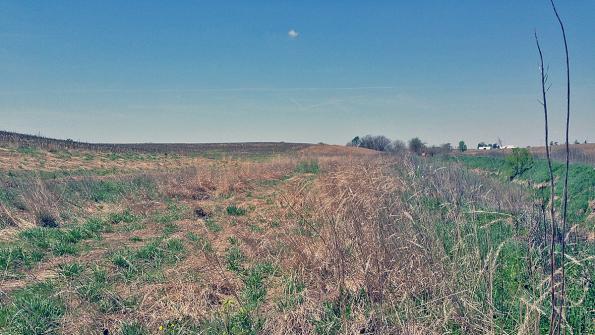March 24, 2016

Illinois farmer Brian Parkinson promotes conservation — and not just to protect soil and water.
“A lot of conservation practices — once you get them working well — turn out to be an economic advantage, so you make more money,” says Parkinson, a corn and soybean grower from Reynolds, Ill.
Parkinson began no-tilling in the 1990s. “No-till was an instant success for me.”
He used to run a chisel plow on corn ground and a field cultivator on soybean ground, but was losing topsoil to tillage erosion. “Rock County SWCD had a no-till drill for rent. So I planted 40 acres of soybeans with it the first year, and it was super. The next year, I went 100% no-till, and it worked great. It was a huge labor saver, and an obvious cost benefit.”
Over time, there have been soil quality benefits, too. Earthworm activity is huge. When he digs into the soil, “I see the wormholes and casts, the fungus and hyphae,” which build soil structure.
“No-till absolutely gives you the best bang for your buck on soil conservation,” says Parkinson.
Cover crop learning curve
Even though Parkinson has been no-tilling continuously for more than two decades, “We still have erosion with the planter.” So he’s been experimenting with cover crops for the last three years, seeking erosion control and nutrient sequestration. “I don’t expect cover crops to add to yield.”
Parkinson has aerial-seeded a variety of different covers, but “I’m still looking for the right mix for our locale.” His first trials have been “a relative failure,” he admits. Problems included poor establishment, incomplete termination and delayed germination into the following year’s cash crop. Still, he’s not giving up on covers. “We will make them work, eventually.”
Parkinson has planted 60- to 120-foot-wide grass buffers along all the streams and ditches traversing his farm. And he spends a lot of time maintaining grass waterways within fields. “A lot of grass waterways may look nice — but many of them aren’t really doing what they are supposed to do.” It’s common, he says, to see ditches on one or both sides of poorly maintained grass waterways, which transport a lot of nutrient-laden sediment.
Parkinson quit applying fall nitrogen several years ago, after anhydrous ammonia “became so expensive. I didn’t want to risk losing any of it over the winter.”
Now, he applies all his nitrogen in the spring with a nitrification inhibitor — practices that limit environmental risk, says Joe Gates, district conservationist for Rock Island, Ill., NRCS. In 2015, “there was an excellent payback on N-Serve,” Parkinson adds. These practices “allow me to be more economically competitive.”
Parkinson’s integrated approach is the key to cutting nutrient losses from farm fields in the Upper Mississippi River Basin, Gates says. You need “a whole system of conservation practices. Everything has to work together. No one thing is enough.”
About the Author(s)
You May Also Like




